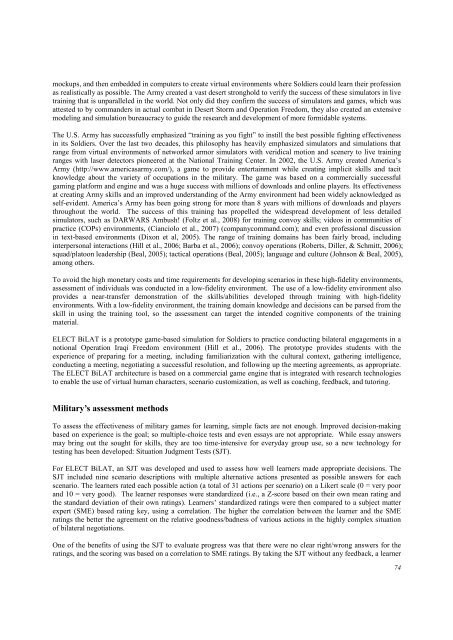Download Complete Issue in PDF - Educational Technology & Society
Download Complete Issue in PDF - Educational Technology & Society
Download Complete Issue in PDF - Educational Technology & Society
You also want an ePaper? Increase the reach of your titles
YUMPU automatically turns print PDFs into web optimized ePapers that Google loves.
mockups, and then embedded <strong>in</strong> computers to create virtual environments where Soldiers could learn their profession<br />
as realistically as possible. The Army created a vast desert stronghold to verify the success of these simulators <strong>in</strong> live<br />
tra<strong>in</strong><strong>in</strong>g that is unparalleled <strong>in</strong> the world. Not only did they confirm the success of simulators and games, which was<br />
attested to by commanders <strong>in</strong> actual combat <strong>in</strong> Desert Storm and Operation Freedom, they also created an extensive<br />
model<strong>in</strong>g and simulation bureaucracy to guide the research and development of more formidable systems.<br />
The U.S. Army has successfully emphasized “tra<strong>in</strong><strong>in</strong>g as you fight” to <strong>in</strong>still the best possible fight<strong>in</strong>g effectiveness<br />
<strong>in</strong> its Soldiers. Over the last two decades, this philosophy has heavily emphasized simulators and simulations that<br />
range from virtual environments of networked armor simulators with veridical motion and scenery to live tra<strong>in</strong><strong>in</strong>g<br />
ranges with laser detectors pioneered at the National Tra<strong>in</strong><strong>in</strong>g Center. In 2002, the U.S. Army created America’s<br />
Army (http://www.americasarmy.com/), a game to provide enterta<strong>in</strong>ment while creat<strong>in</strong>g implicit skills and tacit<br />
knowledge about the variety of occupations <strong>in</strong> the military. The game was based on a commercially successful<br />
gam<strong>in</strong>g platform and eng<strong>in</strong>e and was a huge success with millions of downloads and onl<strong>in</strong>e players. Its effectiveness<br />
at creat<strong>in</strong>g Army skills and an improved understand<strong>in</strong>g of the Army environment had been widely acknowledged as<br />
self-evident. America’s Army has been go<strong>in</strong>g strong for more than 8 years with millions of downloads and players<br />
throughout the world. The success of this tra<strong>in</strong><strong>in</strong>g has propelled the widespread development of less detailed<br />
simulators, such as DARWARS Ambush! (Foltz et al., 2008) for tra<strong>in</strong><strong>in</strong>g convoy skills; videos <strong>in</strong> communities of<br />
practice (COPs) environments, (Cianciolo et al., 2007) (companycommand.com); and even professional discussion<br />
<strong>in</strong> text-based environments (Dixon et al, 2005). The range of tra<strong>in</strong><strong>in</strong>g doma<strong>in</strong>s has been fairly broad, <strong>in</strong>clud<strong>in</strong>g<br />
<strong>in</strong>terpersonal <strong>in</strong>teractions (Hill et al., 2006; Barba et al., 2006); convoy operations (Roberts, Diller, & Schmitt, 2006);<br />
squad/platoon leadership (Beal, 2005); tactical operations (Beal, 2005); language and culture (Johnson & Beal, 2005),<br />
among others.<br />
To avoid the high monetary costs and time requirements for develop<strong>in</strong>g scenarios <strong>in</strong> these high-fidelity environments,<br />
assessment of <strong>in</strong>dividuals was conducted <strong>in</strong> a low-fidelity environment. The use of a low-fidelity environment also<br />
provides a near-transfer demonstration of the skills/abilities developed through tra<strong>in</strong><strong>in</strong>g with high-fidelity<br />
environments. With a low-fidelity environment, the tra<strong>in</strong><strong>in</strong>g doma<strong>in</strong> knowledge and decisions can be parsed from the<br />
skill <strong>in</strong> us<strong>in</strong>g the tra<strong>in</strong><strong>in</strong>g tool, so the assessment can target the <strong>in</strong>tended cognitive components of the tra<strong>in</strong><strong>in</strong>g<br />
material.<br />
ELECT BiLAT is a prototype game-based simulation for Soldiers to practice conduct<strong>in</strong>g bilateral engagements <strong>in</strong> a<br />
notional Operation Iraqi Freedom environment (Hill et al., 2006). The prototype provides students with the<br />
experience of prepar<strong>in</strong>g for a meet<strong>in</strong>g, <strong>in</strong>clud<strong>in</strong>g familiarization with the cultural context, gather<strong>in</strong>g <strong>in</strong>telligence,<br />
conduct<strong>in</strong>g a meet<strong>in</strong>g, negotiat<strong>in</strong>g a successful resolution, and follow<strong>in</strong>g up the meet<strong>in</strong>g agreements, as appropriate.<br />
The ELECT BiLAT architecture is based on a commercial game eng<strong>in</strong>e that is <strong>in</strong>tegrated with research technologies<br />
to enable the use of virtual human characters, scenario customization, as well as coach<strong>in</strong>g, feedback, and tutor<strong>in</strong>g.<br />
Military’s assessment methods<br />
To assess the effectiveness of military games for learn<strong>in</strong>g, simple facts are not enough. Improved decision-mak<strong>in</strong>g<br />
based on experience is the goal; so multiple-choice tests and even essays are not appropriate. While essay answers<br />
may br<strong>in</strong>g out the sought for skills, they are too time-<strong>in</strong>tensive for everyday group use, so a new technology for<br />
test<strong>in</strong>g has been developed: Situation Judgment Tests (SJT).<br />
For ELECT BiLAT, an SJT was developed and used to assess how well learners made appropriate decisions. The<br />
SJT <strong>in</strong>cluded n<strong>in</strong>e scenario descriptions with multiple alternative actions presented as possible answers for each<br />
scenario. The learners rated each possible action (a total of 31 actions per scenario) on a Likert scale (0 = very poor<br />
and 10 = very good). The learner responses were standardized (i.e., a Z-score based on their own mean rat<strong>in</strong>g and<br />
the standard deviation of their own rat<strong>in</strong>gs). Learners’ standardized rat<strong>in</strong>gs were then compared to a subject matter<br />
expert (SME) based rat<strong>in</strong>g key, us<strong>in</strong>g a correlation. The higher the correlation between the learner and the SME<br />
rat<strong>in</strong>gs the better the agreement on the relative goodness/badness of various actions <strong>in</strong> the highly complex situation<br />
of bilateral negotiations.<br />
One of the benefits of us<strong>in</strong>g the SJT to evaluate progress was that there were no clear right/wrong answers for the<br />
rat<strong>in</strong>gs, and the scor<strong>in</strong>g was based on a correlation to SME rat<strong>in</strong>gs. By tak<strong>in</strong>g the SJT without any feedback, a learner<br />
74

















